Compere Roles: Server and Client
Every Juggler is already running its own instance of Compere. Any PC added to the network, running Compere, provides a user interface (UI) into the network and can join a Project Group, but it does not need to remain present. Every Project Group member shares the same Project file and edits are sent back to the Project Group server to distribute. Any instance of Compere in the Project Group can be assigned the role of server and become the holder and distributor of the Project (as ‘stage manager’). Any instance of Compere joining a Project Group will receive the server’s Project file. Any edits made to the Project file whilst offline will be lost.
Each network Project Group looks after itself, so that if the server instance of Compere drops out another can be assigned the role. For this reason a control PC running Compere UI should not be assigned as server.
Jugglers or PCs running Compere in the Project Group can also be specifically addressed using external control commands sent from another PC to the Project Group server.
Project Group Server
In this role, Compere can connect to any number of clients but does not connect to other servers directly. A server shares its projects with clients and there can only be one server per Project Group.
Project Group Client
In this role, Compere can connect to any number of servers but does not connect to other clients directly. A client does not share its own projects, so any Project opened on a client will be dropped on joining a Group with a server.
Every instance of Compere can be either online or offline. If online it can be acting as a client or as a server. This toolbar button/switch shows online status:

One instance of Compere (only) is assigned as Project Group server, all others are clients. If the server fails, a different client can be configured as the Project Group server. A control PC (e.g. a laptop) is able to assign any Juggler as server. The control PC can therefore be taken away or reinserted once the system is configured and running. Alternatively, redundancy or control bandwidth can be built into a system by dedicating a permanent control PC ready as server.
Configure the Network
Go to Configuration > Network Configuration where, in the ‘Discovery’ tab you should see all Compere devices (Control PC and all Jugglers) on the local network:
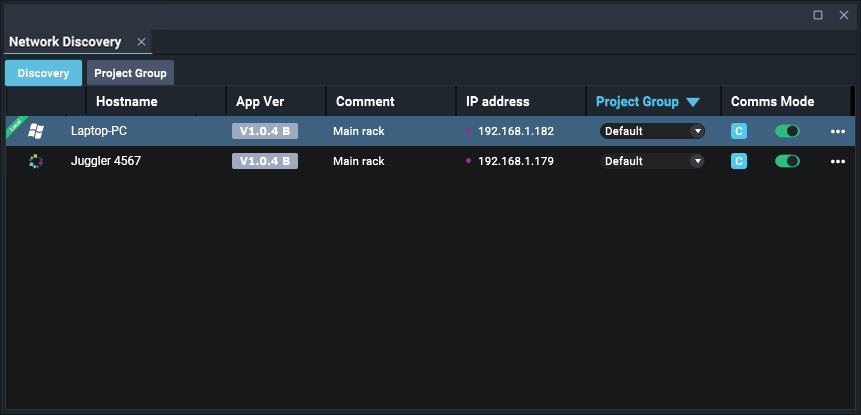
Your instance of Compere has the green flash across it marked ‘Local’.
Discovery tab
Columns ‘Hostname’, ‘IP Address’, and ‘Project Group’ in this tab can be sorted by clicking on the column heads.
Hostname
This is the name that has been given to Juggler units (or PC). Initially these will be the names assigned when they were built.
App Ver
Different versions of Compere might conflict within a Project Group. This column shows the version on each instance of Compere in grey. If there are different versions of Compere running this may not present a problem, but a blue alert is given indicating that different versions are in play. (Note: if Debug mode is enabled, the Compere version information is the more specific fingerprint.)
Comment
Edit this for clarification of location, role, etc., for your own use.
IP address
Shows the current IP of each unit.
Note: The internal IP range for all Jugglers is 172.30.n.n so do not use this range for your network of Jugglers and other devices. |
Project Group
Which devices are going to share the Project file (‘stage manager script’)? Jugglers communicate by being assigned to a Project (Network) Group. Initially, all instances of Compere available on the network appear under a Group label ‘Default’, which is not a communications group. Project Groups are created in the other tab of this panel. Project Group is directly selectable here from the list of Project Groups you set up. Once in a named Group any instance of Compere can be put back into the Default pool.
You must also belong to the same to the same Group as the Jugglers with which you want to share a Project.
Comms Mode
Offline, or online as client or server. The adjacent marker shows if online.
Click ‘Apply’ before any other changes, such as adding a Binding NIC. You may see an orange bar with the alert that ‘Network Configuration is in a temporary state’. |
Each Compere host shown here requires configuring, so click on the three dots to open the ‘Edit Config’ dialog. Here you need to edit the Comms Mode to assign a role (Off, Server or Client):
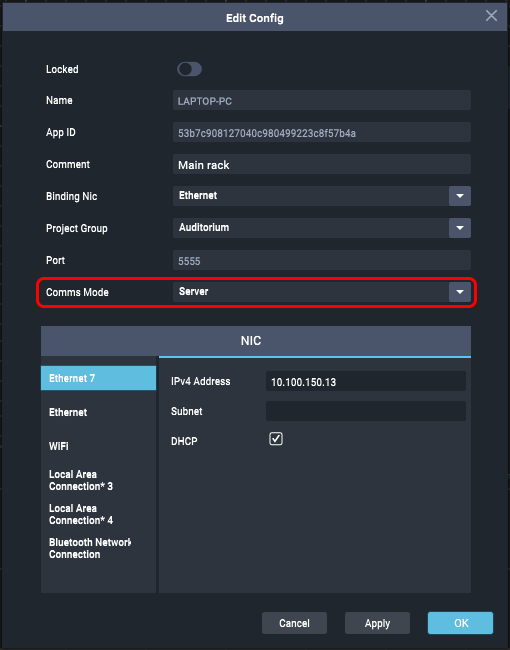
You must have one instance of Compere running as server per Project Group. Where the role is server, there must be a binding NIC: in the lower panel you can see details of available NICs. If joining a Group with no server, there will be a warning message to alert you here, and in the Discovery list:
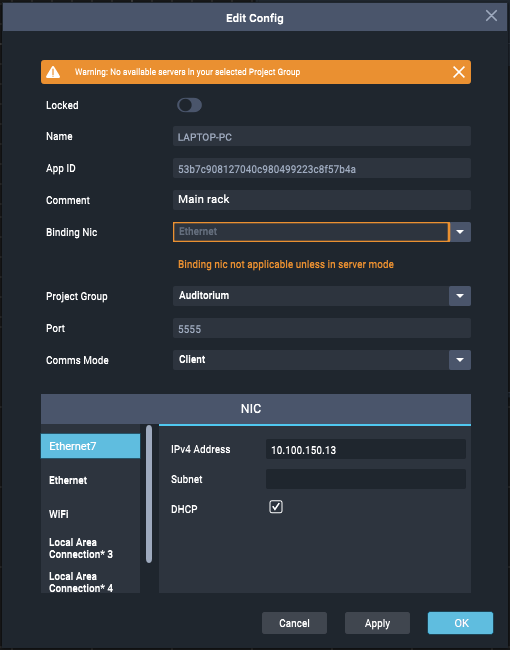
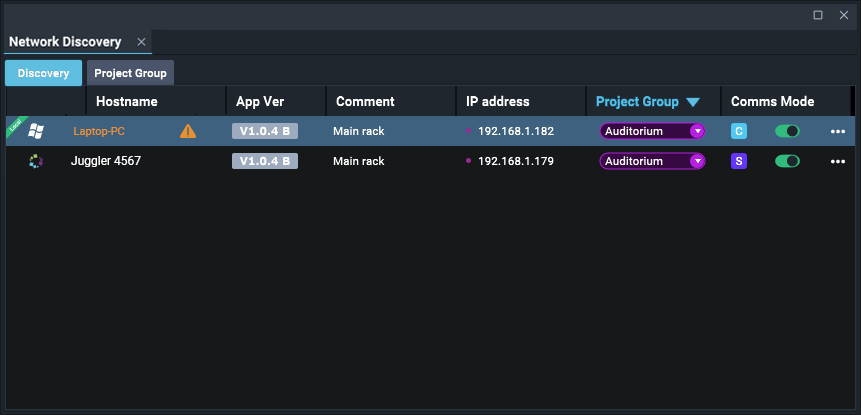
You cannot have two servers on binding NICs in the same range, and an orange warning will appear to indicate any conflict. You cannot have two servers in the same Project Group. Trying to add a second will be prevented, with a red warning message displayed.
Locked
Secure your settings by checking this box.
App ID
Not editable: identifies this instance of Compere.
Comment
Adds a brief description to the Discover list.
Port
Default Compere comms port is 5555; edit another free port as required.
Do I need to create Project Groups?
No, if you do not need multiple Project Groups. The initial default is that unassigned devices will communicate with each other in an uneditable group called ‘Default’. If you do not need multiple groups of devices, Default will be your Group. If you do create Project Group(s), make sure all Compere instances are assigned to created Groups, not the Default Group, and with one server role in each Group.
Once you have configured one instance of Compere as server, configure all the others as clients. The assigned role will remain with the instance of Compere, wherever it goes, until reconfigured.
The server-assigned Compere will hold the initial configuration for the Project. The Project file can then be saved locally and as server, it will be distributed to all other instances of Compere in the Project Group. In the event of losing a server connection, any Juggler can subsequently be handed the role of server and redistribute the project.
This example shows instances of Compere set up using Project Groups:
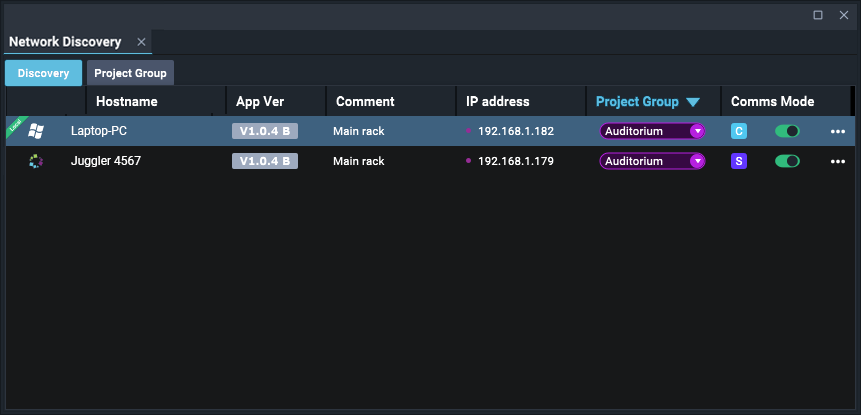
The Project Group members, and only the Group members, are shown in the Compere Project panel. Jugglers not in this Group will not be seen, and do not participate in the Project running in this Group.
Changing to another Project Group
Role takes precedence.
•If the instance of Compere being moved to a Project Group is a client, it will adopt the Project being distributed by the Group server.
•If the instance of Compere is a server and is being moved into a Group without a current server, it will distribute the Project that it is currently running.
Before moving an instance of Compere into a Group, check first how you want to join – as server or client.
... as an online client
Your instance of Compere will be given the Project file of the Project Group by the server in that Group, on joining. You will see the alert regarding your current Project:

... as an online server
If you are joining a Project Group that has no current server (maybe it has failed or been withdrawn), you will be asked if you want to create a new Project. If not, then as a server your current Project will be distributed to the client Group, which will be reconnected.
You cannot join a Project Group that has a server, if your role is also server.
Lost Network Connection
There must be an instance of Compere running as server in a Juggler system. If the server is disconnected or fails for any reason, the status bar of Compere on an editing PC will be red:

Clients continue to run with the Project but are no longer synchronised and no changes are exchanged.
Page edited [d/m/y]: 26/09/2022